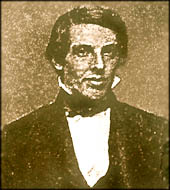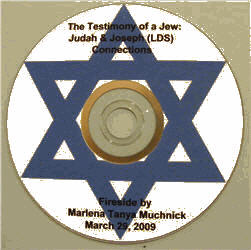Nine tenths of those who come into this Church are the pure blood of Israel, the greater portion being purely of the blood of Ephraim. He was the first-born, and the first blessing of old Jacob was upon Ephraim. Joseph was a saviour to the house of his father, and will be to the whole house of Israel in the last days. We are Israel, we are already a portion of that venerable house. . . . You will never see a man called to preside in the Priesthood of God on the earth who is not purely of the blood of Abraham. –Brigham Young.
 Mormon Israelism is peculiar, both in regards to the indigenous population of the American continents as well as to persistent beliefs, readily observed in the patriarchal blessings of each member, that most members are descendants of and heirs to the ten lost tribes of Israel. It is consequently no surprise that Mormonism figures prominently in Zvi Ben-Dor Benite’s recent world history of the ten tribes. However, Benite fundamentally miscomprehends Mormonism in relation to his subject.
Mormon Israelism is peculiar, both in regards to the indigenous population of the American continents as well as to persistent beliefs, readily observed in the patriarchal blessings of each member, that most members are descendants of and heirs to the ten lost tribes of Israel. It is consequently no surprise that Mormonism figures prominently in Zvi Ben-Dor Benite’s recent world history of the ten tribes. However, Benite fundamentally miscomprehends Mormonism in relation to his subject. Benite’s stated task is a world history, tracing the ten tribes across time and place, from the kernels of historicity to the most developed modern myths and beliefs. Overall, he succeeds in communicating that history. The story of the tribes is vast, spanning millennia of cultural evolution and exchange. After introducing his volume, Benite begins with the foundational narrative of the Bible, which describes the political division of Israel and Judah, followed by Assyria’s subsequent defeat and depopulation of Northern Israel. Importantly, Benite uses extant Assyrian records and up-to-date scholarship to contextualize not only the actual events but the consumption of their interpretation within the self-reinforcing framework of contemporary Assyrian propaganda. This framework then expands as the known world expands from the Persian and Islamic spheres of influence and then to the New World.
The significance of the ten tribes to various religions and their spiritualization is also a key theme throughout the work. Perhaps due to the popularity of authors such as Margaret Barker, the idea of Josiah’s reformation with its crafty Deuteronomists may not be as unpalatable to Mormons as it might have been just a few years ago. Benite shows just how such reformations transformed the lost ten tribes into a spiritual (and political) force. The lost tribes as a contiguous people, however, do not really exist until after the Jewish Bible. “The rudiments of a tale about the loss of an Israelite group were encoded in the biblical era,” writes Benite, “but the emergence of a distinct entity known as ‘the lost tribes’ or the ‘ten tribes’ is a legacy of the postbiblical period, and it is only then that the ten tribes come into being as a distinct collective category within ‘the people of Israel’ and are assigned a distinct place within world geography and a role in world history” (58). Perhaps the most significant development in the history of the tribes was the creation of the book of 2 Esdras, a pseudepigraphal work, which, building upon other apocrypha, elucidated the theology and geography of the tribes.
Through reinterpretation, rabbinic and other, the tribes chose exile for purity’s sake and became a powerful people. Midrashic sources describe their return, from across a sabbatic river and from deep within the earth. The history is punctuated with pivotal appearances by characters, frauds–pious or not–that expanded the myth and for some, gave it concrete reality. The current state of Israel naturalizes the Falasha (Jewish Ethopians) based on the association of Ethopia with the tribe of Dan by Eldad ha-Dani, one such ninth-century trickster.
Christian interest in the ten tribes is of rather late vintage. It was not until the second millennium C.E. that Christians engaged the tribes, exchanging knowledge with Jews, with each crafting narratives favorable to their own perspectives. Christians associated the tribe with the myth of Prester John. Benite shows how, with the expanding world, both Protestants and Catholics sought for the ten tribes, first on the borders of the Old World, then in the Canary Islands, and then in the New World. The belief that native peoples in the American continents were the lost tribes was common well into the nineteenth century. Benite also addresses the origins of British Israelism, another important context for Mormonism (see here).
Benite’s unfamiliarity with Mormonism, however, is betrayed by casual mistakes: referring to the Church as “the Mormon Church of the Latter-day Saints” (187) and dating the Kirtland Temple theophany to 1831 (186). He relied heavily on R. Clayton Brough’s The Lost Tribes for the bulk of his Mormon sources. This volume, while somewhat useful, is dated and historiographical flawed. Benite frames the tribes in a theology of loss (14–22) which the author rightly recognizes as being reflected in Mormonism (185 & 198). The garden of Eden, Zion (both ancient and modern), and Israel were all just beyond the reach of early Mormons and served as archetypes for the Restoration. However, Benite does not see this broader resonance and is not clear in his explication of the Book of Mormon, framing it as an attempt to save the history of the ten lost tribes and their American landing from science, which was beginning to dismantle such theories:
As revelations, Mormon claims are immune to any scientific challenge—not the case with the Jewish Indian theory, which relied on ethnographic findings. Nevertheless, scientific challenges to Mormonism have been an integral part of its history since its inception. And for its part, Mormon science is interested in proving the correlation between the various nations mentioned in the Book of Mormon and, for instance, the mound builders. (187)
Though many nineteenth-century authors such as Ethan Smith asserted an American geography for the ten tribes, the Book of Mormon does not. The bulk of its narrative revolves around Hebrews which traveled to America before the Babylonian captivity. True, the Book of Mormon incorporates the history of similar refugees led by God from before the Assyrian deportation and after the tower of Babel, but all the characters of the Book are outside of the lost tribes.
Furthermore, as evidenced in the opening quotation of this review, Mormons not only saw Hebrews in Native Americans, but also in themselves. Benite acknowledged early Mormon discourse regarding Zion and Israel, but he failed to see the prominent and intense belief that Mormons are literally descendants of the lost tribes. Related to British Israelism, early Mormons generally viewed the tribes as assimilated in the cultures of the world. Their descendants were indistinguishable from the unmixed populations except by their reaction to the gospel. Two years after the organization of the Church, the Evening and Morning Star printed “The Ten Tribes,” an article, which delineated the early Mormon view, based on tradition but also heavily influenced by the Book of Mormon’s allegory of the olive tree (Jacob 5), that God scattered the tribes all over the world.
Joseph Smith and other early Mormons did appear to believe in the traditional eschatological return of the remnant tribes from “the northern countries,” but it is not until the early and middle twentieth century that Mormon leaders invested more heavily in the myth, with many believing in supernaturally obscured intact tribes. By J. Stapley
Search this interesting blogsite: www.bycommonconsent.com A 2010 article























